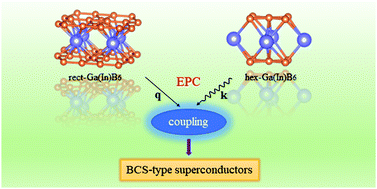Superconductivity in predicted two dimensional XB6 (X = Ga, In)†
Abstract
Recently, two-dimensional (2D) rect-AlB6 [B. Song, Y. Zhou, H.-M. Yang, J.-H. Liao, L.-M. Yang, X.-B. Yang and E. Ganz, J. Am. Chem. Soc., 2019, 141, 3630–3640] has been reported to be an excellent system, exhibiting intrinsic superconductivity. Here, on the basis of the CALYPSO structure prediction method and first-principles calculations, we predict two novel systems of 2D XB6 (rect- and hex-XB6) (X = Ga, In), verify their thermal stability and calculate their mechanical properties. Then, we study their bonding nature, electron and phonon properties, and electron–phonon coupling (EPC). The results show that rect-, hex-GaB6, rect- and hex-InB6 are intrinsic phonon-mediated superconductors with a superconducting transition temperature (Tc) of 1.67, 14.02, 7.77 and 4.83 K, respectively. Furthermore, we study the influence of strain on these intrinsic superconductors. Their Tc can be modulated to some extent, especially for hex-InB6, the Tc of which can be enhanced to 19.23 K under the compressive strain of 2%. According to our calculations, they may be prepared by growing on suitable substrates, such as Cu(100) and Pt(111). Our findings may broaden the configurations of 2D superconducting materials and will stimulate more efforts in this field.



 Please wait while we load your content...
Please wait while we load your content...